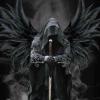 Submitted by Damos Kniat on
Submitted by Damos Kniat on
![]()
By Shubi(Shubi) - Self-made just for fun., Public Domain, https://commons.wikimedia.org/w/index.php?curid=1960208
In Lovecraft’s stories, the Necronomicon is described as an ancient text compiled by Abdul Alhazred (called the “Mad Arab”) in the 8th century, containing magical spells and incantations for summoning monsters and archaic deities. In one story, Lovecraft states that Alhazred wrote the text after exploring Babylonian and Egyptian ruins.
Prankish rumors that the Necronomicon was an actual, historical text have circulated since the 1930s, leading to several hoax editions that claim to present the “real” text of this fictional book. The most famous of these is the “Simon Necronomicon,” named for its pseudomononymous compiler (widely believed to be occultist Peter Levenda). The book is cobbled together from a mishmash of recontextualized Sumerian and Babylonian texts peppered with added references to fictional deities created by Lovecraft and the orientalist magical system of Aleister Crowley. Simon’s text plagiarizes the work of pioneering Assyriologists like R.C. Thompson, from whose Devils and Evil Spirits of Babylonia (ISAW Small Collection PJ3791.T5 1903 v.1-2) many of the translations are lifted. In their original context, these texts were incantations against evil spirits and the various ills they caused, not spells for conjuring them. (“Simon” has a tendency to present descriptions of demons’ evil natures in English, but slips back into transliterated Akkadian when the texts begin to call for the spirits to be cast out, leading to an implication that the demons are being invoked rather than exorcised.) These ancient Mesopotamian incantations have come to be considered “satanic” through a centuries-long process of reinterpretation. The Simon Necronomicon reads its ancient sources through a combination of medieval demonology, 19th-century Theosophy, and 20th-century pulp fiction.
But despite its clear origins as a hoax, the Simon Necronomicon has been used as evidence in murder trials like that of Rod Ferrell and his so-called “Vampire Clan.” In 1996, Ferrell murdered the parents of one of his friends in a brutal but mundane home invasion. But numerous factors that emerged in media coverage of the crime-- including Ferrell’s self-identification as a vampire and the discovery of a copy of the Simon Necronomicon in his car--led to the murders being reframed as a satanic ritual killing. (Laycock discusses the Farrell case in his 2009 sociological study Vampires Today: The Truth About Modern Vampirism.) In cases like Ferrell’s, crusading prosecutors, self-proclaimed “cult cops,” and the sensation-seeking news media have held the Necronomicon up as proof of a shadowy satanic conspiracy. This imaginary-turned-real book presents an intriguing case study in how the ancient sacred and the modern secular have combined into a new hybrid.
Lovecraft, “Simon” (the compiler of the Simon Necronomicon), and the anti-cult crusaders all trade in different misinterpretations of history. The general public knows just enough about the history of the ancient Near East for it to view it as a place of mystery and strangeness. Indeed, this reputation is itself an inheritance from the ancient world, as Greeks and Romans saw “magic” as coming from the East (In Book 30.2 of his Natural History Pliny the Elder declares that "there is no doubt that this art originated in Persia."). This proto-orientalism, combined with historical illiteracy--or perhaps committed distrust of “history” as an elite conspiracy in itself--has led to the mystification of antiquity as something incomprehensible, occult, or even satanic. This has opened the door for both outright fraudsters and what Laycock calls “moral entrepreneurs” to write their own chimerical histories, inserting the names of ancient places and deities into imagined struggles between cosmic good and evil. These faulty constructions of history depend on ignorance. We actually know quite a lot about ancient Near Eastern cultures and their religious practices--and the ISAW Library contains many of the fruits of this knowledge--but historical fabrications expect and depend on ignorance. The more we learn, and the better we communicate that knowledge, the more tools we will have for opposing misconstructed history.
Gabriel McKee